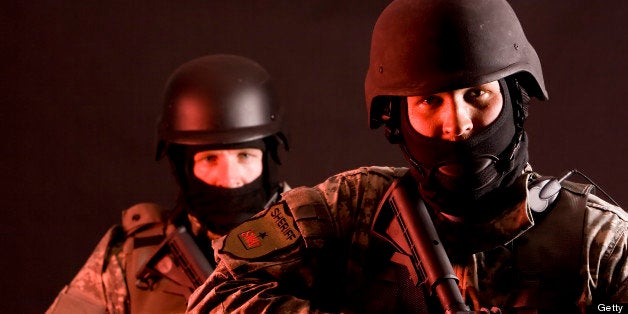
"I'm too old for this s--t," the deputy says as we wait on the bus for processing. He is 65 years old. "I feel sorry for the ones coming up, I couldn't do 25 years of this." He is referring to a lack of public appreciation for police.
We are outside the Urban Shield expo of militarized equipment for police and other agencies. From where we sat in peacefully at the Alameda County Fairgrounds, we could see men in military fatigues entering the expo. As part of Urban Shield occurring in the Bay Area this weekend, dozens of SWAT teams from northern California, Mexico, and beyond also are competing in extreme exercise scenarios that must have a "nexus to terrorism," according to Homeland Security funding criteria.
The deputy continues. "Just like not everyone in prison is guilty, not every police officer is bad."
I'm down with that. But it's not really the point. If you are a good person, a police officer, and I give you military tools for fighting enemies, if prosecutors don't hold your peers accountable when they commit crimes or use excessive force, if you don't live in the community where you work, if you are not aware of implicit racial bias or toxic masculinity, then even you as a good person will likely commit abuses.
Alameda County Sheriff spokesman J.D. Nelson claims that police militarization is nothing new, that police have used military technology for a hundred years. This would not be reassuring, even if it were true. After all, Southern police departments first adopted the .38 revolver - a measure of militarization at the time - on the basis of spurious and racist claims that black men high on cocaine were resistant to lower caliber bullets.
Today's normalization of militarized policing is evident in the phrase "first responders," which conflates police with fire and EMS personnel, and removes from the meaning of law enforcement its capacity for force and violence. It also makes invisible those who are typically first responders: family, neighbors, and other community members. The phrase sounds so good, especially when Sheriff spokesmen reference emergencies such as earthquakes. Of course we want agencies that will help us prepare for and respond to natural disasters. But why would you want a SWAT team to be the first to respond to an earthquake?
In fact, many community-based initiatives in California's East Bay - where Urban Shield is centered - respond to emergencies, including Community Emergency Response Trainings, People's Community Medics, and Learn, Lead, Lift, which trains low-income communities in emergency preparedness.
The other image invoked for Urban Shield training is of terrorists hell-bent on killing and destroying, for which no negotiation or de-escalation skills supposedly can be applied. In fact, an FBI study of 160 active shooter incidents found that a majority of the incidents ended on the shooter's initiative, most before police arrived on the scene; in 21 incidents, unarmed citizens - primarily staff and students in school shootings - safely restrained the shooter.
Urban Shield training is actually applied to much more ordinary law enforcement. Two thirds of SWAT team deployments in 2014-2015 disclosed by police departments that participated in Urban Shield and responded to public records requests were for serving search, arrests and parole warrants, rather than for situations requiring specialized tactical capacities. Limited data indicate they also were deployed disproportionately against people of color, consistent with a national study by the American Civil Liberties Union.
As criticism of policing in the United States has increased, it's become more important for police to maintain the narrative that they are "good guys" going up against "the bad guys." That's why the deputy so desperately wanted the community to see him as a "good guy." Yet no one always behaves as wholly "good" or "bad."
The Alameda County Sheriff's deputy who arrested me put on plastic cuffs and zipped them tight against my wrists, until they cut off circulation and stopped the feeling in my thumb. Safariland, which produces such cuffs, was also vending its wares inside Urban Shield. (One online ad for these cuffs says to "please use carefully when releasing your hostage." Your hostage.) As I write, more than a day later, some of my thumb is still numb.
Others arrested with me, mostly white, also had highly constricted plastic cuffs that cut off feeling. This tight application of cuffs can produce nerve damage. When asked to adjust them, officers simply ignored us for awhile. It was a version for white people of casually applied indifference-cum-brutality. I know officers are human, of course, and would like to believe they are mostly "good guys," but so often, institutions generate police behavior that doesn't reinforce that idea.
A colleague of mine who comes from a family with many police officers observes that police are exposed to the worst in people, while also having enormous power. They are, after all, authorized to use lethal force in some circumstances. The combination of pessimism with power, he notes, has awful consequences. And current training focused on worst-case scenarios reinforces both of these features.
To construct genuine security, we and our local, state and national officials must decide to shift resources away from militarized law enforcement and toward underfunded programs for community emergency response, mental health care, education, and housing.